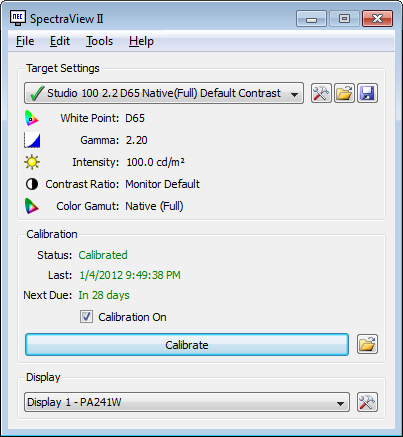
Since I wasn’t using Epson ink or paper, I can only use the Epson settings to “get close” to accurate color.
Colormunki display drivers driver#
This would be a critical test from the beginning because if you are using Epson printer, ink and paper, the settings in the Epson print driver (paper type) actually call a profile included with the Epson software installation. I chose to create a profile for an Epson printer, using third-party ink (not Epson) and Red River Placid Lite semi-gloss paper. That brought a quick smile, but the true test was to come with the printer. However, at the conclusion of the monitor profiling operation, both my primary and secondary displays matched. My secondary display, the old ViewSonic, hadn’t been calibrated since… gosh, I can’t remember. I had profiled my monitor a few weeks prior with another device, but ColorMunki did make an improvement (while subjective at this point, it was proven later after I profiled a printer). Move the wheel to the lower detent, put the device in the accompanying pouch and hang it over your display (the pouch has a weighted strap to hold the ColorMunki in place). Profiling the monitor(s) was just as easy.

It tells you both the strength and quality of the ambient light. To measure the ambient light, rotate the wheel to the upper detent, set the ColorMunki device near your display and click the button to start reading the light values. The ColorMunki is powered by a USB port on your computer, so connecting it both powers the device and interfaces with the application. Calibrating the ColorMunki is simple rotate the wheel to the calibrate detent and click a button (on the ColorMunki or on screen). The device has a rotary wheel with detents at specified locations. I selected the “Match My Printer to My Display” option and followed the step-by-step instructions on the ColorMunki application to first calibrate the ColorMunki hardware device, a full-spectrum Spectrophotometer, measure the ambient lighting in my work area and then calibrate the monitor. So, I used the LCD setting for my 10-year-old Viewsonic CRT. Although the application shows both my monitors (primary and secondary), there is no discrete setting for a CRT, just LCD, laptop and projector. I used ColorMunki to set my dual monitor setup, both a Samsung 22 inch LCD and a 21 inch older ViewSonic CRT (there is no limit to the number of displays). The ColorMunki™, from x-rite, can create both monitor and print profiles (icc or icm files) and it does so efficiently and with noticeable accuracy. If you use third-party (non-OEM) paper or ink, there is absolutely no way you will get accurate color without a printer profile. Change any one of those three and there is a potential for a color shift. Some monitors need to be calibrated every week, but for most of us, monthly calibration will suffice.Īccurate color output from inkjet printers is dependent on the printer, ink, and paper combination. In fact, a monitor, be it LCD ot CRT, changes over time-and not a long time either. There are two main factors that affect how we view these images on our monitors: ambient lighting in the work area, and the monitor’s ability to reproduce the color gamut accurately. Therefore, when editing images, it’s common for the color values to look different from when you took the picture.

We tend to trust the manufacturer that the colors captured are true to what we saw through the view finder, but that really depends on a few other factors, i.e., exposure settings and white balance.
Colormunki display drivers professional#
The DSLR is a fine instrument and most Canon, Nikon and Pentax cameras, from entry-level to high end, multi-thousand dollar professional cameras are capable of capturing millions of pixels of information. After spending money on a quality monitor and an inkjet printer, how do you know if you’re getting the best color reproduction possible? If you don’t edit your images on a calibrated monitor, you can’t possibly guarantee accurate color.


 0 kommentar(er)
0 kommentar(er)
